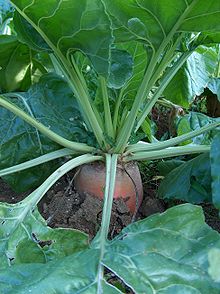Workhouse Farms in Ireland
 |
| Mangel Wurzel-a popular vegetable grown in Irish workhouses |
For a long time, the 'work' in Irish workhouses was thought to exclude farming. However, recent research shows that many Irish workhouses had farms. Due to irregular or no account keeping, it is hard for us to piece together a picture of what farming was like in a workhouse setting. However, what we can do is look at a snap shot of figures from parliamentary documents.* These documents reveal a surprising fact. Out of the 163 workhouses across Ireland, only 37 had no land under cultivation. Over half of these 37 are from the second wave of building.
Workhouse
building in Ireland took place in two waves. There were the first 130
which were planned as a complete set to provide relief for 1% of the
Irish population. Then the crisis resulting from potato blight led to 33
extra workhouses being hastily built. These were needed due to chronic
overcrowding and it seems that acquiring farmland was the least of their
concerns. It is probable that some of these extra workhouses did not
expect to remain open very long. Portumna workhouse is one of these 33
later workhouses and is noted as having "no land attached" in the 1850s parliamentary documents.
Let's return now to the 126 workhouses which had a farm. What were they growing?
The crops listed in 1852-53 include:
Wheat
Oats
Barley
Green Crops
Flax
Turnips
Potatoes
Corn
Onions
Mangel Wurzel
The mysterious Mangel Wurzel is not as exotic as it sounds. A mangel is simply a variety of large root vegetable. This crop was so popular in the 19th century that entire books were dedicated to its
cultivation such as Thomas Newby's exciting 1828 volume 'Remarks on Mangel Wurzel'.
In his book we learn that this large root vegetable
"has every advantage with the turnip, both for the food of man and beast, without being subject to the ravages of any insect whilst in its infant state..."
Hardiness and resistance to disease was a major concern for farmers in this era as many 19th century plants were more susceptible to problems than today's varieties. Farmers in the 1800s also had the added challenge of having to grow all their crops from seed.
| Typical Victorian seed catalogue |
If we take a closer look at some workhouses in the Galway area, we can see that Loughrea records
140 males employed on their farm, cultivating 13 acres. They
list crops such as oats, turnips, barley and other vegetables.
Ballinasloe has 50 males to work their 4
acres, 2 roods and 34 perches of land. They do not list crop varieties
but simply state that they cultivate flax and vegetables. They do note that their surplus vegetables and manure are
disposed of by auction. This shows that Ballinasloe workhouse had livestock as well as crops. In fact, there is a parliamentary questionnaire
issued to Irish workhouses just for assessing livestock purchases. This indicates that Ballinasloe was not exceptional in keeping animals.
The total land under workhouse cultivation in the 1850s was around 1200 acres, with 5,240 males engaged in agriculture and 1,144 women. Much of this produce was used in-house but surplus was sold with the year 1852 generating 1564 pounds, 2 shilling, 8 and half pence in sales.The sale of livestock (dead or
alive) generated 816 pounds, 8 shillings, 2 pence. These figures do not include the many workhouses that did not keep accounts.
This small investigation into workhouse farms suggests that working the land was a substantial part of workhouse life if you were male. Far from being cruel, making workhouse inmates engage in farm work, most likely gave paupers a better quality of life. Workhouses which grew their own crops had better and more varied food than institutions that didn't. Critically, workhouses that had a farm were able to include fresh vegetables in their workhouse diet, a vital source of nutrients and vitamins. Working outdoors, away from the stuffy and and disease riven atmosphere of the workhouse would have been a marked improvement as well.
*The information in this article came from two main sources: Return, from each of the Poor Law Unions in England, Wales, and Ireland, showing what kinds of Employment, if any, are carried on in the respective workhouses [...] and Return from each Union in Ireland showing the extent of land under crops [...]
Both were accessed via House of Commons Parliamentary Papers OnlineAuthor: Elizabeth Carter


Casino Roll - Casino Roll - Casinoguru
ReplyDeleteIt's a slot game that's made by Playtech that brings ㅅ ㅇㅌ 추천 together a variety 슈어맨 of bonus features, a unique bonus 유로 스타 사이트 round, and 윌리엄 힐 an instant 토토 사이트 중계 play mode. Play the game!